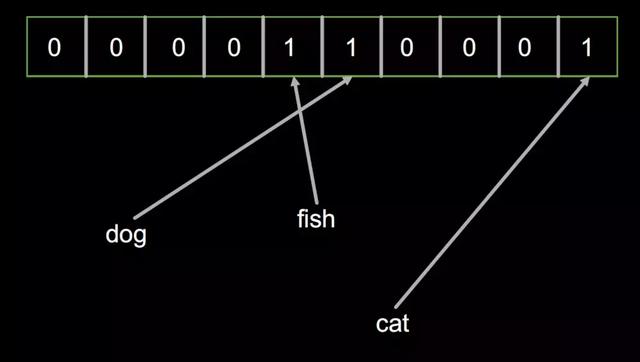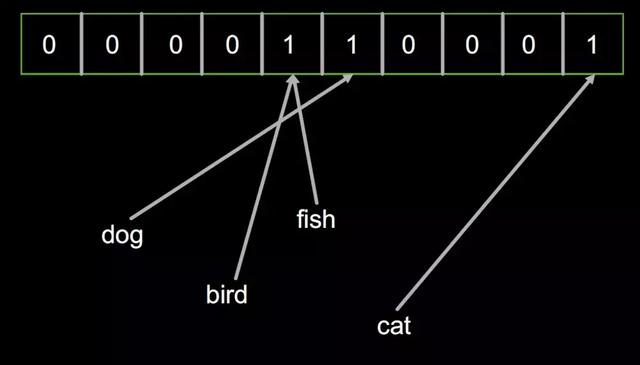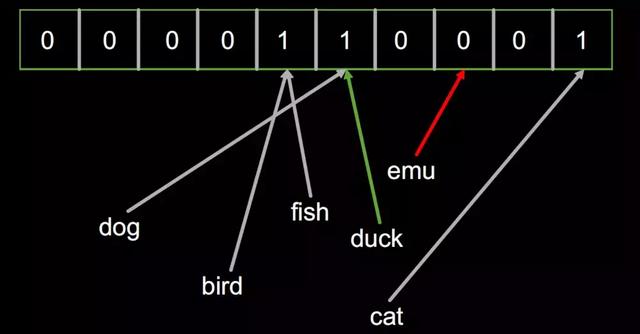基于Python語言的大數據搜索引擎
搜索是大數據領域里常見的需求。Splunk和ELK分別是該領域在非開源和開源領域里的***。本文利用很少的Python代碼實現了一個基本的數據搜索功能,試圖讓大家理解大數據搜索的基本原理。
布隆過濾器 (Bloom Filter)
***步我們先要實現一個布隆過濾器。
布隆過濾器是大數據領域的一個常見算法,它的目的是過濾掉那些不是目標的元素。也就是說如果一個要搜索的詞并不存在與我的數據中,那么它可以以很快的速度返回目標不存在。
讓我們看看以下布隆過濾器的代碼:
- class Bloomfilter(object):
- """
- A Bloom filter is a probabilistic data-structure that trades space for accuracy
- when determining if a value is in a set. It can tell you if a value was possibly
- added, or if it was definitely not added, but it can't tell you for certain that
- it was added.
- """
- def __init__(self, size):
- """Setup the BF with the appropriate size"""
- self.values = [False] * size
- self.size = size
- def hash_value(self, value):
- """Hash the value provided and scale it to fit the BF size"""
- return hash(value) % self.size
- def add_value(self, value):
- """Add a value to the BF"""
- h = self.hash_value(value)
- self.values[h] = True
- def might_contain(self, value):
- """Check if the value might be in the BF"""
- h = self.hash_value(value)
- return self.values[h]
- def print_contents(self):
- """Dump the contents of the BF for debugging purposes"""
- print self.values
- 基本的數據結構是個數組(實際上是個位圖,用1/0來記錄數據是否存在),初始化是沒有任何內容,所以全部置False。實際的使用當中,該數組的長度是非常大的,以保證效率。
- 利用哈希算法來決定數據應該存在哪一位,也就是數組的索引
- 當一個數據被加入到布隆過濾器的時候,計算它的哈希值然后把相應的位置為True
- 當檢查一個數據是否已經存在或者說被索引過的時候,只要檢查對應的哈希值所在的位的True/Fasle
看到這里,大家應該可以看出,如果布隆過濾器返回False,那么數據一定是沒有索引過的,然而如果返回True,那也不能說數據一定就已經被索引過。在搜索過程中使用布隆過濾器可以使得很多沒有***的搜索提前返回來提高效率。
我們看看這段 code是如何運行的:
- bf = Bloomfilter(10)
- bf.add_value('dog')
- bf.add_value('fish')
- bf.add_value('cat')
- bf.print_contents()
- bf.add_value('bird')
- bf.print_contents()
- # Note: contents are unchanged after adding bird - it collides
- for term in ['dog', 'fish', 'cat', 'bird', 'duck', 'emu']:
- print '{}: {} {}'.format(term, bf.hash_value(term), bf.might_contain(term))
結果:
- [False, False, False, False, True, True, False, False, False, True]
- [False, False, False, False, True, True, False, False, False, True]
- dog: 5 True
- fish: 4 True
- cat: 9 True
- bird: 9 True
- duck: 5 True
- emu: 8 False
首先創建了一個容量為10的的布隆過濾器

然后分別加入 ‘dog’,‘fish’,‘cat’三個對象,這時的布隆過濾器的內容如下:

然后加入‘bird’對象,布隆過濾器的內容并沒有改變,因為‘bird’和‘fish’恰好擁有相同的哈希。

***我們檢查一堆對象('dog', 'fish', 'cat', 'bird', 'duck', 'emu')是不是已經被索引了。結果發現‘duck’返回True,2而‘emu’返回False。因為‘duck’的哈希恰好和‘dog’是一樣的。

分詞
下面一步我們要實現分詞。 分詞的目的是要把我們的文本數據分割成可搜索的最小單元,也就是詞。這里我們主要針對英語,因為中文的分詞涉及到自然語言處理,比較復雜,而英文基本只要用標點符號就好了。
下面我們看看分詞的代碼:
- def major_segments(s):
- """
- Perform major segmenting on a string. Split the string by all of the major
- breaks, and return the set of everything found. The breaks in this implementation
- are single characters, but in Splunk proper they can be multiple characters.
- A set is used because ordering doesn't matter, and duplicates are bad.
- """
- major_breaks = ' '
- last = -1
- results = set()
- # enumerate() will give us (0, s[0]), (1, s[1]), ...
- for idx, ch in enumerate(s):
- if ch in major_breaks:
- segment = s[last+1:idx]
- results.add(segment)
- last = idx
- # The last character may not be a break so always capture
- # the last segment (which may end up being "", but yolo)
- segment = s[last+1:]
- results.add(segment)
- return results
主要分割
主要分割使用空格來分詞,實際的分詞邏輯中,還會有其它的分隔符。例如Splunk的缺省分割符包括以下這些,用戶也可以定義自己的分割符。
- ] < > ( ) { } | ! ; , ' " * s & ? + %21 %26 %2526 %3B %7C %20 %2B %3D -- %2520 %5D %5B %3A %0A %2C %28 %29
- def minor_segments(s):
- """
- Perform minor segmenting on a string. This is like major
- segmenting, except it also captures from the start of the
- input to each break.
- """
- minor_breaks = '_.'
- last = -1
- results = set()
- for idx, ch in enumerate(s):
- if ch in minor_breaks:
- segment = s[last+1:idx]
- results.add(segment)
- segment = s[:idx]
- results.add(segment)
- last = idx
- segment = s[last+1:]
- results.add(segment)
- results.add(s)
- return results
次要分割
次要分割和主要分割的邏輯類似,只是還會把從開始部分到當前分割的結果加入。例如“1.2.3.4”的次要分割會有1,2,3,4,1.2,1.2.3
- def segments(event):
- """Simple wrapper around major_segments / minor_segments"""
- results = set()
- for major in major_segments(event):
- for minor in minor_segments(major):
- results.add(minor)
- return results
分詞的邏輯就是對文本先進行主要分割,對每一個主要分割在進行次要分割。然后把所有分出來的詞返回。
我們看看這段 code是如何運行的:
- for term in segments('src_ip = 1.2.3.4'):
- print term
- src
- 1.2
- 1.2.3.4
- src_ip
- 3
- 1
- 1.2.3
- ip
- 2
- =
- 4
搜索
好了,有個分詞和布隆過濾器這兩個利器的支撐后,我們就可以來實現搜索的功能了。
上代碼:
- class Splunk(object):
- def __init__(self):
- self.bf = Bloomfilter(64)
- self.terms = {} # Dictionary of term to set of events
- self.events = []
- def add_event(self, event):
- """Adds an event to this object"""
- # Generate a unique ID for the event, and save it
- event_id = len(self.events)
- self.events.append(event)
- # Add each term to the bloomfilter, and track the event by each term
- for term in segments(event):
- self.bf.add_value(term)
- if term not in self.terms:
- self.terms[term] = set()
- self.terms[term].add(event_id)
- def search(self, term):
- """Search for a single term, and yield all the events that contain it"""
- # In Splunk this runs in O(1), and is likely to be in filesystem cache (memory)
- if not self.bf.might_contain(term):
- return
- # In Splunk this probably runs in O(log N) where N is the number of terms in the tsidx
- if term not in self.terms:
- return
- for event_id in sorted(self.terms[term]):
- yield self.events[event_id]
- Splunk代表一個擁有搜索功能的索引集合
- 每一個集合中包含一個布隆過濾器,一個倒排詞表(字典),和一個存儲所有事件的數組
- 當一個事件被加入到索引的時候,會做以下的邏輯
- 為每一個事件生成一個unqie id,這里就是序號
- 對事件進行分詞,把每一個詞加入到倒排詞表,也就是每一個詞對應的事件的id的映射結構,注意,一個詞可能對應多個事件,所以倒排表的的值是一個Set。倒排表是絕大部分搜索引擎的核心功能。
- 當一個詞被搜索的時候,會做以下的邏輯
- 檢查布隆過濾器,如果為假,直接返回
- 檢查詞表,如果被搜索單詞不在詞表中,直接返回
- 在倒排表中找到所有對應的事件id,然后返回事件的內容
我們運行下看看把:
- s = Splunk()
- s.add_event('src_ip = 1.2.3.4')
- s.add_event('src_ip = 5.6.7.8')
- s.add_event('dst_ip = 1.2.3.4')
- for event in s.search('1.2.3.4'):
- print event
- print '-'
- for event in s.search('src_ip'):
- print event
- print '-'
- for event in s.search('ip'):
- print event
- src_ip = 1.2.3.4
- dst_ip = 1.2.3.4
- -
- src_ip = 1.2.3.4
- src_ip = 5.6.7.8
- -
- src_ip = 1.2.3.4
- src_ip = 5.6.7.8
- dst_ip = 1.2.3.4
是不是很贊!
更復雜的搜索
更進一步,在搜索過程中,我們想用And和Or來實現更復雜的搜索邏輯。
上代碼:
- class SplunkM(object):
- def __init__(self):
- self.bf = Bloomfilter(64)
- self.terms = {} # Dictionary of term to set of events
- self.events = []
- def add_event(self, event):
- """Adds an event to this object"""
- # Generate a unique ID for the event, and save it
- event_id = len(self.events)
- self.events.append(event)
- # Add each term to the bloomfilter, and track the event by each term
- for term in segments(event):
- self.bf.add_value(term)
- if term not in self.terms:
- self.terms[term] = set()
- self.terms[term].add(event_id)
- def search_all(self, terms):
- """Search for an AND of all terms"""
- # Start with the universe of all events...
- results = set(range(len(self.events)))
- for term in terms:
- # If a term isn't present at all then we can stop looking
- if not self.bf.might_contain(term):
- return
- if term not in self.terms:
- return
- # Drop events that don't match from our results
- results = results.intersection(self.terms[term])
- for event_id in sorted(results):
- yield self.events[event_id]
- def search_any(self, terms):
- """Search for an OR of all terms"""
- results = set()
- for term in terms:
- # If a term isn't present, we skip it, but don't stop
- if not self.bf.might_contain(term):
- continue
- if term not in self.terms:
- continue
- # Add these events to our results
- results = results.union(self.terms[term])
- for event_id in sorted(results):
- yield self.events[event_id]
利用Python集合的intersection和union操作,可以很方便的支持And(求交集)和Or(求合集)的操作。
運行結果如下:
- s = SplunkM()
- s.add_event('src_ip = 1.2.3.4')
- s.add_event('src_ip = 5.6.7.8')
- s.add_event('dst_ip = 1.2.3.4')
- for event in s.search_all(['src_ip', '5.6']):
- print event
- print '-'
- for event in s.search_any(['src_ip', 'dst_ip']):
- print event
- src_ip = 5.6.7.8
- -
- src_ip = 1.2.3.4
- src_ip = 5.6.7.8
- dst_ip = 1.2.3.4
總結
以上的代碼只是為了說明大數據搜索的基本原理,包括布隆過濾器,分詞和倒排表。如果大家真的想要利用這代碼來實現真正的搜索功能,還差的太遠。




























